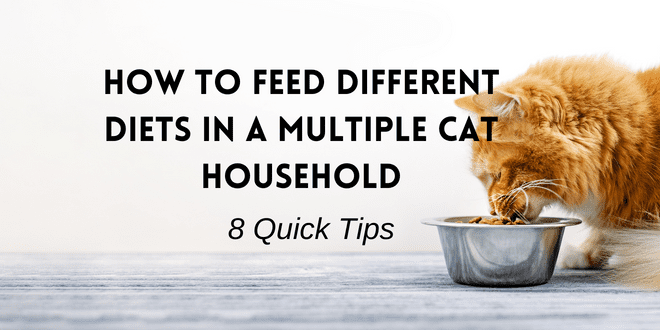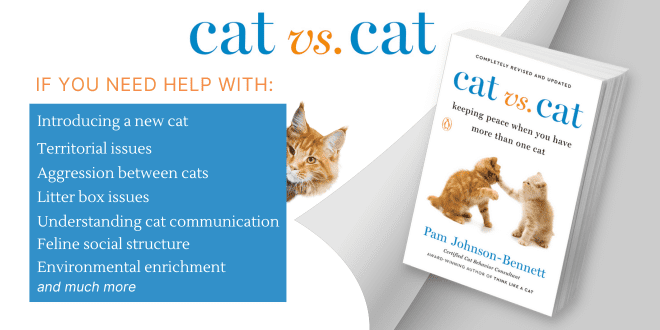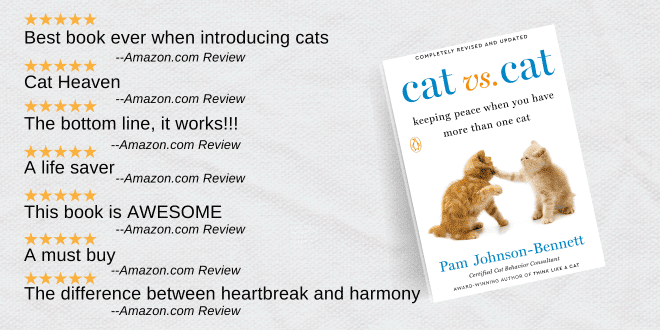
Living in a multiple cat household has so many wonderful rewards and benefits but it also comes with a few challenges. One of those challenges many cat parents face is how to manage feeding time. It can become a struggle to keep one cat out of another cat’s food bowl. A cat parent begins to feel more like a kindergarten playground monitor or even a traffic cop whenever mealtime comes around.
The mealtime routine can get even more complicated when one or more cats must eat a special diet. The reasons for individualized diets can vary greatly. You may need to feed growth formula to a kitten while trying to keep the adult cats focused on their own food, or maybe one cat has been prescribed a special diet for chronic renal failure or even a reduced calorie diet for weight management. Whatever the reason, it can be difficult to keep cats from wandering away from their own bowls to check out what another cat is eating.
Feeding individualized meals may seem like an impossible task in a multiple cat household but with a little planning and patience, it can be done. Here are 8 tips to get you started.
1. Have the Needed Supplies for Feeding Your Cats
If you’ve been feeding out of one big food bowl for all of the cats, you need to get the right supplies before you implement a new mealtime plan. Each cat will need their own food bowls. If a number of the cats will be eating specific diets then it may help to buy bowls of different colors or types so you can more easily keep track of who gets what food. The cats certainly won’t care about color but when you’re trying to remember what food you put in a specific bowl, it’ll help. You can also write the cats’ names on all the bowls with a permanent marker. Develop whatever plan you need so you, or anyone else feeding your cats won’t accidentally offer the wrong food to the wrong cat.
2. Take it Slow
Abrupt changes in food can be upsetting to a cat’s stomach and may also lead one or more of the cats to reject the new formula. In general, cats don’t like change so any diet changeover should be done gradually. Talk to your veterinarian about the best way to do the change based on your specific cats and based on the urgency of any medical condition that requires the nutritional change. Unless your veterinarian instructs otherwise, a changeover to a different diet should be done gradually, over the course of about 5-7 days by adding a little of the new food into the current food and then increasing the new formula a little each day and decreasing the amount of the old type.
3. No Free-Feeding
When all the cats were eating the same food, especially if it involved dry food, you may have simply left out an endless supply in one bowl for cats to munch on as they pleased throughout the day. Even if you weren’t about to embark on specialized diets for one or more of the cats, free-feeding is not the best way to go. When there’s a bottomless bowl of food you have no way of monitoring how much each cat is eating. It may seem convenient at first but it can also lead to obesity or it can create some resource-guarding between cats if there’s only one food source. One cat may have developed the habit of sneaking into the kitchen in the wee hours of the morning when no one else is around because he’s afraid of being intimidated or attacked by another cat.
As you make the transition from free-feeding to scheduled meals, start by doing more frequent meals (divide up the portions so you’re not overfeeding) and making a big announcement when it’s mealtime so the kitties can get used to the new routine. Make it a gradual and easy transition so you don’t end up with one or more cats sitting in the kitchen wondering what happened to their food.
4. Create Individual Feeding Stations for Your Cats
Depending on how many cats you have or how determined some of them may be about gaining access to another kitty’s food, the stations could be located all in the same room or you may have to set certain ones up in different rooms. Mealtime shouldn’t be a time of stress or fear so if it’s too difficult to keep one cat away from another, the easiest thing to do is create feeding stations in totally separate areas.
If you plan on feeding the cats in one room, don’t place the bowls right next to each other. Social dining is more of a human thing and most cats will feel a little more comfortable when there’s space between food bowls. When you have distance between the bowls it also gives you more time to step in and gently guide a wayward cat back to his own bowl. If the bowls are right next to each other then one cat can stick his nose in a companion cat’s bowl before you even realize it.
If you end creating feeding stations throughout the house, remember to have additional water bowls in those rooms as well.
5. Monitor Mealtime
Having to hang around while the cats eat certainly isn’t the most convenient but it’s the best way to ensure all cats eat their own food. Your presence can also ease tension one or more cats may feel if they’ve been the victim of resource guarding. Monitoring is also essential when you feed a prescription food because it can make a huge difference in the health of the kitty patient. If you’re feeding growth formula to a kitten, it’s crucial the youngster get that specific food which is higher in protein and fat than adult formula.
6. Make Adjustments
As you start the process you may find you have to make adjustments along the way. If you have one cat who gulps his food down in order to visit the other food bowls then he will obviously need more supervision or you may have to place him in a separate room. Sometimes just pushing his food down in the bowl so he has to work a little harder to get it may be all that’s needed.
You may also realize that one or more of the feeding stations need to be elevated. Perhaps the only way to keep the overweight cat from getting the kitten’s food is to feed the kitten in an elevated spot.
7. Satisfy the All-Day Foragers with Puzzle Feeders
If your cats were die-hard grazers who loved sauntering in and out of the kitchen for one or two bites of dry food throughout the day, you can still offer a version of that in a way that’s much more beneficial. Set up some puzzle feeders around the house that contain dry food. The cats can enjoy some bonus playtime as they move the food-dispensing toys around and end up with an edible prize. This way the cats are eating less of the carbohydrate-filled food than they would if you just placed a bowl of it out in the kitchen, but they’re still able to enjoy some snacks during the day.
Puzzle feeders come in all shapes and sizes. A simple online search for puzzle feeders will provide many options for purchasing or even making your own. One of the easiest puzzle feeders to make is to cut holes in plastic water bottles, drop some dry food inside and then put the caps back on. Place the bottles on their sides and you have a very cheap and effective puzzle feeder. You can also make wet food puzzle feeders by dividing food into each compartment of a muffin tin.
8. Don’t Give Up
Doing a changeover from feeding the cats all the same food or from free-feeding will require planning and patience but it’s worth it to ensure their continued good health. Don’t give up. If you’re frustrated or are having trouble, talk to your veterinarian for advice.
And remember, if you’re doing a diet changeover that wasn’t prescribed by your veterinarian, make sure you discuss your plans with the doctor first before making any nutritional adjustments.
Need More Information?
This article is not intended to be a replacement for the veterinary advice you need for your individual situation. If you have questions about your cat’s health or nutritional requirements, contact your veterinarian.
For more information about cat behavior and training, you can find answers in the best-selling books by Pam Johnson-Bennett. If you live with more than one cat, check out the revised and updated edition of Cat vs Cat. Pam’s best-selling book on managing multicat households. Pam’s books are available in bookstores and online. We’ve included links to Amazon here on our website.
If you have a question about your cat’s behavior or health, contact your veterinarian. This article is not intended as a medical diagnosis nor is it a replacement for your cat’s regular veterinary care. This article is for general information purposes only.




